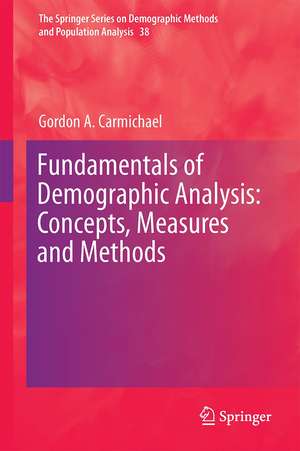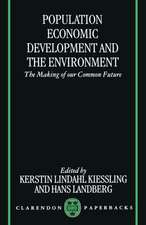Fundamentals of Demographic Analysis: Concepts, Measures and Methods: The Springer Series on Demographic Methods and Population Analysis, cartea 38
Autor Gordon A. Carmichaelen Limba Engleză Hardback – 13 noi 2015
The comprehensive, systematic coverage defines basic concepts and introduces data sources; champions the use of Lexis diagrams as a device for visualizing demographic measures; highlights the importance of making comparisons (whether over time or between populations at a point in time) that control for differences in population composition; describes approaches to analyzing mortality, fertility, and migration; and details approaches to the important field of population projection.
Throughout, the author makes the material accessible for readers through careful exposition, the use of examples, and other helpful features. This book's thorough coverage ofbasic concepts and principles lays a firm foundation for anyone contemplating undertaking demographic research, whether in a university setting or in a professional employment that takes on a demographic dimension requiring in-house training.
| Toate formatele și edițiile | Preț | Express |
|---|---|---|
| Paperback (1) | 844.07 lei 38-44 zile | |
| Springer International Publishing – 23 aug 2016 | 844.07 lei 38-44 zile | |
| Hardback (1) | 904.85 lei 38-44 zile | |
| Springer International Publishing – 13 noi 2015 | 904.85 lei 38-44 zile |
Din seria The Springer Series on Demographic Methods and Population Analysis
- 18%
 Preț: 951.14 lei
Preț: 951.14 lei - 15%
 Preț: 643.99 lei
Preț: 643.99 lei - 15%
 Preț: 643.16 lei
Preț: 643.16 lei - 18%
 Preț: 955.56 lei
Preț: 955.56 lei - 18%
 Preț: 952.40 lei
Preț: 952.40 lei -
 Preț: 393.90 lei
Preț: 393.90 lei -
 Preț: 393.74 lei
Preț: 393.74 lei - 15%
 Preț: 639.08 lei
Preț: 639.08 lei - 18%
 Preț: 952.89 lei
Preț: 952.89 lei - 18%
 Preț: 1118.45 lei
Preț: 1118.45 lei -
 Preț: 402.17 lei
Preț: 402.17 lei - 18%
 Preț: 953.82 lei
Preț: 953.82 lei - 15%
 Preț: 644.30 lei
Preț: 644.30 lei - 15%
 Preț: 663.93 lei
Preț: 663.93 lei - 18%
 Preț: 1380.95 lei
Preț: 1380.95 lei - 18%
 Preț: 953.65 lei
Preț: 953.65 lei - 18%
 Preț: 949.42 lei
Preț: 949.42 lei - 15%
 Preț: 644.82 lei
Preț: 644.82 lei - 18%
 Preț: 953.03 lei
Preț: 953.03 lei - 18%
 Preț: 952.09 lei
Preț: 952.09 lei - 15%
 Preț: 643.65 lei
Preț: 643.65 lei - 15%
 Preț: 643.99 lei
Preț: 643.99 lei - 15%
 Preț: 644.82 lei
Preț: 644.82 lei - 15%
 Preț: 642.51 lei
Preț: 642.51 lei - 15%
 Preț: 644.95 lei
Preț: 644.95 lei - 15%
 Preț: 635.62 lei
Preț: 635.62 lei
Preț: 904.85 lei
Preț vechi: 1190.58 lei
-24% Nou
Puncte Express: 1357
Preț estimativ în valută:
173.16€ • 188.03$ • 145.46£
173.16€ • 188.03$ • 145.46£
Carte tipărită la comandă
Livrare economică 18-24 aprilie
Preluare comenzi: 021 569.72.76
Specificații
ISBN-13: 9783319232546
ISBN-10: 3319232541
Pagini: 394
Ilustrații: XIII, 394 p.
Dimensiuni: 155 x 235 x 27 mm
Greutate: 0.75 kg
Ediția:1st ed. 2016
Editura: Springer International Publishing
Colecția Springer
Seria The Springer Series on Demographic Methods and Population Analysis
Locul publicării:Cham, Switzerland
ISBN-10: 3319232541
Pagini: 394
Ilustrații: XIII, 394 p.
Dimensiuni: 155 x 235 x 27 mm
Greutate: 0.75 kg
Ediția:1st ed. 2016
Editura: Springer International Publishing
Colecția Springer
Seria The Springer Series on Demographic Methods and Population Analysis
Locul publicării:Cham, Switzerland
Public țintă
ResearchCuprins
Chapter 1 Basic Sources, Concepts, Definitions and Types of Measures.- Chapter 2 Comparison: Standardization and Decomposition.- Chapter 3 The Cohort and Period Approaches to Demographic Analysis.- Chapter 4 Analysis of Mortality: The Life Table and Survival.- Chapter 5 Marriage, Marital Status and Relationships.- Chapter 6 Analysis of Fertility.- Chapter 7 Population Distribution, Urbanization and Migration.- Chapter 8 Stable Population Theory.- Chapter 9 Population Projections.
Recenzii
“The book is comprehensive … thorough in its exposition, and extremely clearly written. … His is a sturdy and readable work, to be recommended as a text or supplementary text in courses emphasizing demographic techniques, and as a handy reference for the working demographer or any serious analyst of human population.” (Thomas K. Burch, Canadian Studies in Population, Vol. 44 (1-2), 2017)
“Unquestionably, this monograph is refreshing and rich in its contents and outlook. … A major strength of this book is the depth and clarity of definitions, measures and methods applied in demographic studies. … I found this monograph invigorating and a useful resource for postgraduate teaching and research. … I must commend the author’s efforts in systematically synthesising and explaining key demographic concepts and measures. This monograph certainly deserves a good place in the catalogue of references on demographic methods.” (Sabu S. Padmadas, European Journal of Population, Vol. 32, 2016)Caracteristici
Offers an introduction to demographic analysis that's ideal for those new to the subject Provides a thorough grounding in basic concepts, principles, and techniques Mindful that the quantitative aptitudes of social science students are varied and aims to be intelligible to the not so numerate and the more numerate alike
















